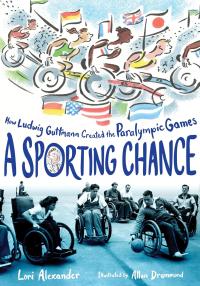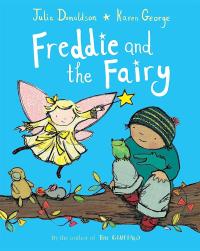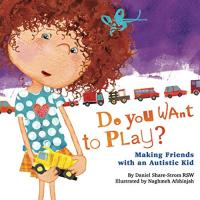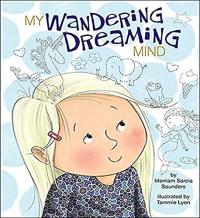
Reluctantly, a child dons itchy winter clothes to accompany her mother to see ice sculptures being created. While there, she loses her beloved toy horse. Magic occurs when they return that evening to see the ice figures at night and the narrator’s horse is found.
A Little Like Magic

Explore elite wheelchair racer, wrestler, America’s Got Talent contestant, and Netflix documentary star Zion Clark’s journey from a childhood lost in the foster care system to his hard-fought rise as a high school wrestler to his current rigorous training to prepare as an elite athlete on the world stage.
Zion Unmatched

Dedicating his life to helping patients labeled “incurables,” Ludwig Guttmann fought for the rights of paraplegics to live a full life. The young doctor believed — and eventually proved — that physical movement is key to healing, a discovery that led him to create the first Paralympic Games.
A Sporting Chance: How Ludwig Guttmann Created the Paralympic Games

A picture book that shares what life can look like for families who use nonverbal communication, utilizing tools to embrace their unique method of speaking. The story is written from the boy’s first-person perspective and highlights the bond between mother and child and follows them on a day where they use a tablet to communicate with others. Written by an autistic mother of two autistic sons.
A Day with No Words

Maggie’s stutter complicates her relationship with her father who wants to send her for “treatment.” Instead, Maggie will spend some time with her grandfather near Wildoak forest where she comes across a snow leopard abandoned by a wealthy Londoner. It is there she finds self-acceptance and a way to communicate for herself and the animal. Inspired by an era when exotic animals could be purchased from a London department store, this moving novel is unforgettable.
Wildoak

A picture book biography about Evelyn Glennie, a deaf woman, who became the first full-time solo percussionist in the world. From the moment Evelyn Glennie heard her first note, music held her heart. She played the piano by ear at age eight, and the clarinet by age ten. But soon, the nerves in her ears began to deteriorate, and Evelyn was told that, as a deaf girl, she could never be a musician. What sounds Evelyn couldn’thear with her ears, though, she could feel resonate through her body as if she, herself, were a drum. And the music she created was extraordinary. Evelyn Glennie had learned how to listen in a new way.
Listen: How Evelyn Glennie, a Deaf Girl, Changed Percussion

Jazz! It’s all about the rhythm and the sounds, musicians in conversation answering each other with notes and riffs instead of words. But what happens when one member of the band can’t hear the notes anymore? Through this rhythmic story, readers meet Lee, who loses his hearing and is asked to leave his band. Luckily, he discovers a whole new world of music that exists in the mind and heart at a local school for the deaf.
The Deaf Musicians

Readers will be transported to the rugged Himalayas with this story of a deaf Sherpa boy in Nepal, who braves a storm in search of his family’s yaks. He finds the animals herded around a young calf whose leg is wedged between rocks. Unable to rescue the animal alone, Kami whistles for help. When no one comes, he slips and slides down the icy mountain to get his father and brother. He relates the problem through mime. Together the family rescues the calf, and the plucky hero proudly leads the way home.
Kami and the Yaks

The story of a father and his deaf son who communicate using sign language. They wake up early one morning and walk to the beach to watch the sunrise.
Dad and Me in the Morning

A young boy listens eagerly to the games on the radio, using sign language to tell his deaf father about every new development. Getting into the spirit, his father begins to keep a scrapbook, clipping newspaper articles and photos about Jackie. One day, the father has big news: they’re going to Ebbets field to watch Jackie play in person!
Dad, Jackie, and Me

Actors from the Little Theatre of the Deaf are coming to Moses’ school, and Moses and his classmates are going to see a play! A class from another school joins them, and Moses is introduced to Manuel, who has just moved to the U.S. Manuel doesn’t know English or sign language yet. Moses, being deaf, knows how hard it can be when no one understands you, so he tries communicating with Manuel using body gestures, while also teaching him some simple signs. The book is written in English and American Sign Language (ASL). Detailed diagrams of the signs are included so that readers can learn along with Manuel.
Moses Sees a Play

A fairytale about a boy who meets a fairy who can’t hear very well. He learns the importance of clear communication and the golden rules for talking to someone who is deaf or hard of hearing.
Freddie and the Fairy

Set in India, this story follows the journey of an elephant who goes on a quest to find his hearing. He meets friends who have different abilities and talents and discovers his own special gift.
Ranvir Cannot Hear

This kid-friendly guide to American Sign Language (ASL) provides an enjoyable and accessible introduction to the language’s fundamentals. It begins with succinct instructions, an alphabet chart that includes a note about finger spelling being acceptable when a sign is not known, and proceeds through a range of everyday words and signs (feelings, colors, shapes, and so forth).
Time to Sign: Sign Language for Kids

This is the story of Gracie, your everyday fun-loving kid who does everything that you do, but has trouble hearing. It’s as if her ears are sleeping! When her family searches for answers, she discovers the wonder of hearing aids and the sounds of the world. Gracie’s Ears introduces what hearing aids are to young children needing help to hear and to their friends who wonder — what are those things in their friend’s ears and what do they do?
Gracie’s Ears

A young girl, filled with the sounds of her beloved city, shares a song with her grandmother that changes the two forever. After helping Grandma realize that the city makes music as beautiful as the sounds they hear in church on Sunday morning, the two sit down and take in all the sounds of the city … together.
Song in the City

This is the story of 17-time Paralympic medalist Tatyana McFadden. Born with spina bifida in Russia, Tatyana was raised in an orphanage where she walked on her hands for the first six years of her life. In 1994, she was adopted and moved to the .S., where she started racing and breaking records; and is now considered the best female wheelchair racer of all time, and the fastest woman on Earth. This is the first book in the non-fiction Paralympians picture book series about 4 champions who do things their own way and are reinventing sport.
Fastest Woman on Earth: The Story of Tatyana McFadden

An accident puts an end to Jordan’s basketball playing but after she finds wounded white elephant, things change. Jordan names him Marshmallow and helps her discover a new sport. The lush Indonesian setting comes alive in charismatic, sprightly illustrations.
Marshmallow and Jordan

“Do you want to play?” That’s what Jamie, with her favorite yellow truck, asks new kid Dylan, who only seems to want to line up his cars. This story gently explores learning about others and finding new ways to have fun. One of the most common issues for kids with autism is friendship. Children’s books sometimes depict the neurotypical child as doing their autistic pal a favor by befriending them, often forcing them to change a part of themselves. This story shows us that children with autism are more than capable of making meaningful contributions to relationships, and suggests how neurotypical children can alter their own approach to create a true connection.
Do You Want to Play? Making Friends with an Autistic Kid

This picture book explores sensory differences. For the young girl in the story, the vibration in her feet when she runs, the tap-tap-tap of her fork on the table at mealtime, the trickle of cool water running over her hand — these are the things that calm her jitters down. This book is for anyone who has ever felt the need for a wiggle, stomp, or squeeze!
Wiggles, Stomps, and Squeezes Calm My Jitters Down

Seven-year-old Anthony has autism. He flaps his hands. He makes strange noises. He can’t speak or otherwise communicate his thoughts. Treatments, therapies, and theories about his condition define his daily existence. Yet Anthony isn’t improving much. This debut work of fiction sheds light on the inner and outer lives of children with nonspeaking autism, and on their two worlds — and how they navigate their way through the multitude of theories about autism that have affected the lives of many children and their families. As one of the few works of fiction written by a person with non-speaking autism, it offers readers an insider’s point-of-view into autism and life in silence, with warmth, humor, and sharp intellect.
In Two Worlds

Vivy Cohen, an 11-year-old with autism, won’t let anything stop her from playing baseball — not when she has a major-league star as her pen pal. This novel-in-letters captures Vivy’s growing sense of her own capabilities. It’s a satisfying baseball story that never minimizes the challenges of autism but celebrates skill, determination, and love for the game.
Get a Grip, Vivy Cohen!

Nobody knows comics trivia like Stanley knows comics trivia. It’s what he takes comfort in when the world around him gets to be too much. And after he faints during a safety assembly, Stanley takes his love of comics up a level by inventing his own imaginary superhero, named John Lockdown, to help him through. Help is what he needs, because Stanley’s entered Trivia Quest — a giant comics-trivia treasure hunt — to prove he can tackle his worries, score VIP passes to Comic Fest, and win back his ex-best friend. See our interview with the author, Sally J. Pla ›
Stanley Will Probably Be Fine

Sadie feels like her thoughts are soaring into the clouds and she can’t bring them back down to earth. She has trouble paying attention, which makes keeping track of schoolwork, friends, chores, and everything else really tough. Sometimes she can only focus on her mistakes. When Sadie talks to her parents about her wandering, dreaming mind, they offer a clever plan to help remind Sadie how amazing she is. Includes a Note to Parents and Caregivers with more information on ADHD, self-esteem, and helping children focus on the positives.
